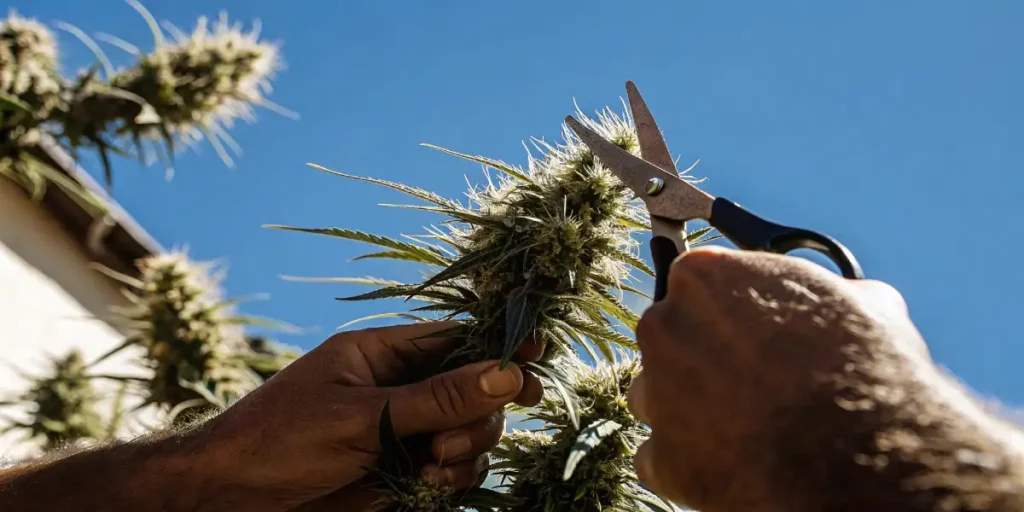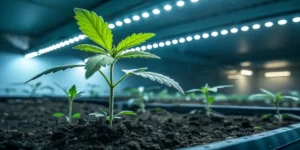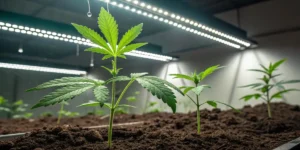Caring for a cannabis plant can be both exciting and rewarding. Whether you’re a first-time grower or a seasoned enthusiast, paying attention to details will significantly impact your plant’s health and yield. If you’re wondering how to take care of a cannabis plant, the key is to understand its basic needs and provide consistent care.
One crucial aspect is selecting the right strain. For beginners, consider starting with a robust strain like Northern Lights. It’s known for its resilience and ease of growth. Experienced growers might try Sour Diesel for its energizing effects.
Another important factor is monitoring the plant’s environment. Factors such as light, temperature, and humidity play a significant role in cannabis growth. Adjusting these elements according to the plant’s stage will help you achieve optimal results.
Choosing the Best Soil for Growing Cannabis Indoors
The foundation of any healthy cannabis plant is the soil. For indoor growing, choosing the best soil is crucial because it impacts water retention, nutrient availability, and aeration. A well-aerated soil ensures that roots receive adequate oxygen, which is vital for growth.
Look for soil that’s rich in organic matter with good drainage properties. Many growers opt for a mix of peat, perlite, and organic compost. This combination promotes healthy root systems and helps prevent issues like root rot. A popular choice among indoor growers is White Widow, which thrives in well-balanced soil.
When selecting the best soil for growing cannabis indoors, it’s essential to consider the pH level. Cannabis plants prefer slightly acidic soil, with a pH level between 6.0 and 7.0. Maintaining this pH range ensures optimal nutrient uptake, promoting vigorous growth and higher yields.
Amending your soil with additional organic materials like worm castings or bat guano can further enhance its quality. These amendments not only enrich the soil with essential nutrients but also improve its structure, making it easier for roots to penetrate and access the nutrients they need to thrive.
How to take care of a cannabis plant: proper watering tips
Watering might seem simple, but overwatering or underwatering can harm your cannabis plant. The key is to water when the top inch of soil feels dry. This prevents root rot and ensures the plant gets enough moisture without drowning the roots.
Use room-temperature water to avoid shocking the plant. Cold water can stunt growth, while hot water might damage the roots. Water slowly and evenly, allowing it to soak through the soil and reach the roots.
Understanding how to water a cannabis plant properly involves more than just timing. The quality of water used is equally important. Tap water often contains chlorine and other chemicals that can harm your plants. Consider using filtered or distilled water to avoid chemical buildup in the soil.
In addition to water quality, the type of watering method can impact plant health. Drip irrigation systems are an excellent choice for providing consistent moisture. They deliver water directly to the root zone, minimizing evaporation and ensuring each plant receives an adequate amount without waste.
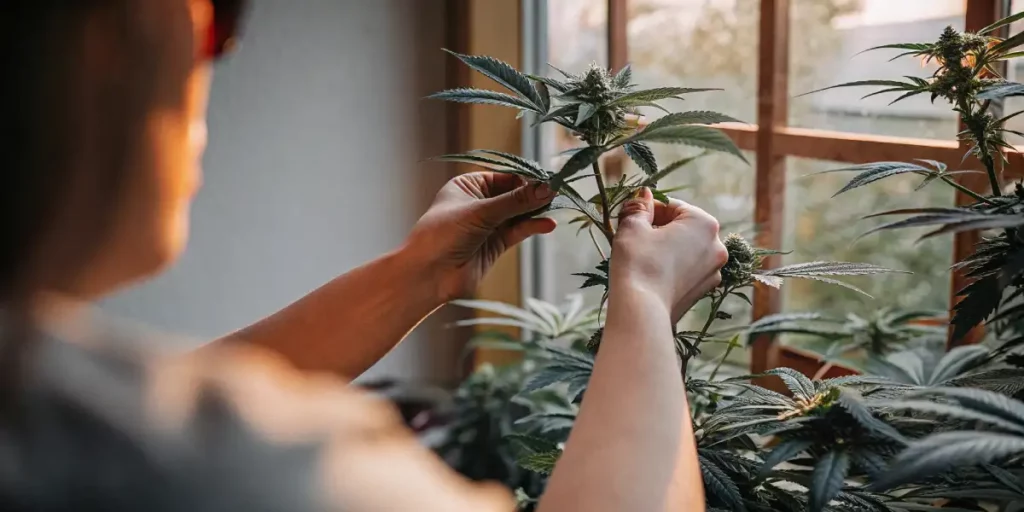
Ideal Light Conditions for Cannabis Growth
Light is a crucial factor in how to take care of a cannabis plant. Cannabis requires ample light to grow and produce buds. For indoor growing, LED lights are a popular choice due to their energy efficiency and ability to provide the full spectrum of light needed for all growth stages.
During the vegetative stage, cannabis plants typically need 18-24 hours of light daily. As they transition to the flowering stage, reduce the light to 12 hours. This mimics the natural light cycle and encourages flowering. Adjusting light schedules based on the plant’s needs can significantly enhance growth.
It’s important to consider the distance between the light source and the plant canopy. Keeping lights too close can lead to light burn, causing damage to leaves and stunting growth. Conversely, lights placed too far away might result in leggy plants with insufficient bud development.
Reflective surfaces can enhance the effectiveness of your lighting setup. By placing reflective materials like mylar or white paint around your grow area, you can maximize light distribution, ensuring even coverage and promoting uniform growth throughout your cannabis plants.
Nutrient Schedule for Cannabis Plants
Providing the right nutrients is another critical aspect of how to take care of a cannabis plant. Cannabis plants require a balanced mix of macronutrients—nitrogen, phosphorus, and potassium—and micronutrients like calcium, magnesium, and iron.
During the vegetative stage, focus on higher nitrogen levels to promote leaf growth. As the plant enters the flowering stage, increase phosphorus and potassium to support bud development. Many growers prefer using a pre-mixed nutrient solution for ease and consistency.
Creating an effective nutrient schedule for cannabis plants involves monitoring plant health and adjusting nutrient ratios accordingly. Leaf color and texture can provide valuable clues about nutrient deficiencies or excesses, allowing you to make timely corrections.
It’s also crucial to consider organic versus synthetic nutrients. Organic options, such as compost teas and natural fertilizers, can enhance soil health and sustainability. However, synthetic nutrients offer precision and control, making them popular among growers aiming for consistent, high-quality yields.
Common Pests Affecting Cannabis Plants and Solutions
Unfortunately, pests are a common issue in cannabis cultivation. Aphids, spider mites, and whiteflies are among the most frequent invaders. These pests can weaken your plant and reduce your yield if not managed promptly.
Prevention is the best strategy. Regularly inspect your plants for signs of infestation, like yellowing leaves or webbing. If you spot pests, act quickly. Neem oil is a natural solution that can deter many common pests without harming your plants.
Understanding how to take care of a cannabis plant means being proactive about pest management. Introducing beneficial insects, such as ladybugs and predatory mites, can provide natural pest control, reducing the need for chemical interventions.
Maintaining a clean and organized grow space is crucial in preventing pest infestations. Removing debris, dead leaves, and other organic matter can eliminate potential breeding grounds for pests, keeping your cannabis plants healthy and thriving.
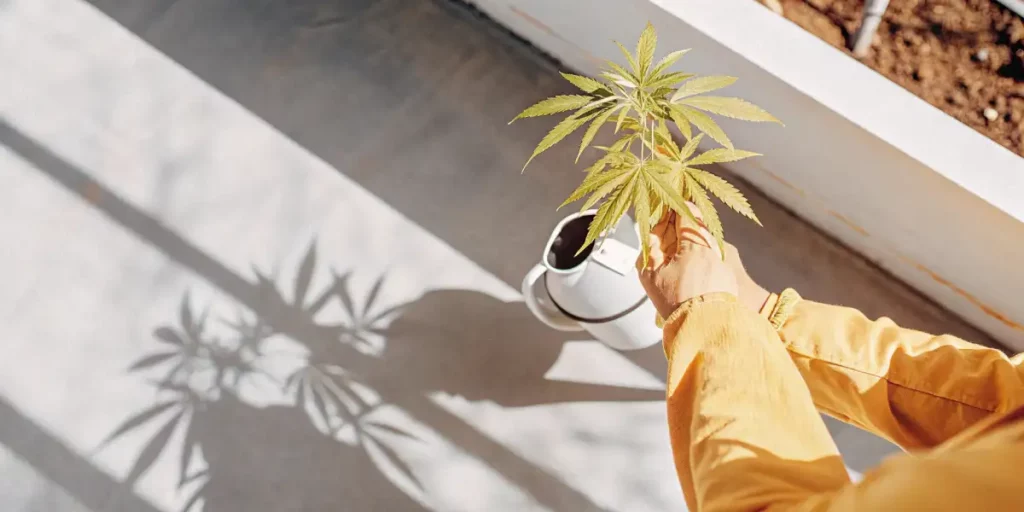
Frequently Asked Questions on How to Take Care of a Cannabis Plant
What is the best soil for growing cannabis indoors?
The best soil for growing cannabis indoors is one that offers good drainage, aeration, and nutrient content. A popular mix includes peat, perlite, and organic compost. This combination supports healthy root development and prevents issues like root rot. Knowing how to take care of a cannabis plant starts with choosing quality soil that’s free from pests and diseases before planting.
Using sterilized soil or commercially prepared potting mixes can further reduce the chances of pest infestations. Some growers also add worm castings or bat guano to enrich the soil with additional nutrients, promoting vigorous plant growth and enhancing the overall health of your cannabis plants.
How to water a cannabis plant properly?
Proper watering involves waiting until the top inch of soil is dry before watering again. This prevents overwatering, which can lead to root rot. Use room-temperature water and water slowly, ensuring it penetrates the soil deeply to reach the roots.
Monitor the plant’s response to watering. Wilting or yellowing leaves can indicate water stress, either from too much or too little water. Adjust your watering schedule based on these signs, and always use pots with drainage holes to prevent waterlogging.
What are the ideal light conditions for cannabis growth?
Ideal light conditions vary by growth stage. During the vegetative stage, cannabis plants benefit from 18-24 hours of light. This promotes rapid growth and sturdy stems. As the plant enters the flowering stage, switch to 12 hours of light and 12 hours of darkness to stimulate bud production.
LED lights are a great choice for indoor growers, providing the necessary spectrum of light for all growth stages. Adjust the height of your lights to prevent light burn and ensure even coverage over your plant’s canopy for optimal growth.
How do I create a nutrient schedule for cannabis plants?
A nutrient schedule should align with the plant’s growth stages. Knowing how to take care of a cannabis plant includes adjusting nutrients properly. During the vegetative stage, focus on nitrogen-rich nutrients to support leaf and stem growth. Transition to phosphorus and potassium-rich nutrients during the flowering stage to enhance bud development.
Start with a lower concentration of nutrients and gradually increase as needed, watching for signs of nutrient burn. It’s also beneficial to flush your plants with plain water every few weeks to prevent nutrient buildup and maintain soil health.
What are the common pests affecting cannabis plants and their solutions?
Common pests include aphids, spider mites, and whiteflies. Regularly inspect your plants for signs such as yellowing leaves or webbing, which can indicate an infestation. Neem oil is an effective organic solution for many pests.
Introduce beneficial insects like ladybugs or predatory mites to naturally control pest populations. Maintaining a clean growing environment and removing any dead plant material can also help prevent pest infestations and protect your cannabis plants.

